Phone:419-677-5035
Free USPS Shipping On Orders Over $35

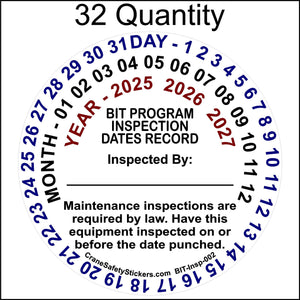
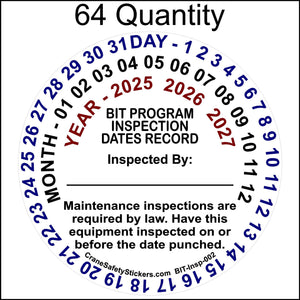
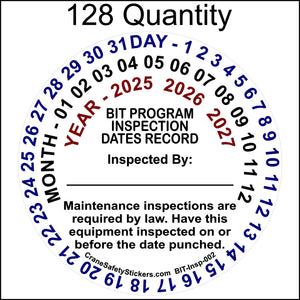
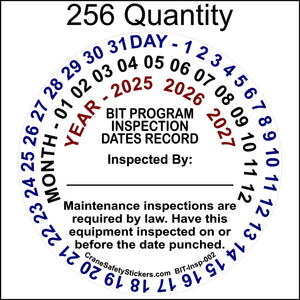
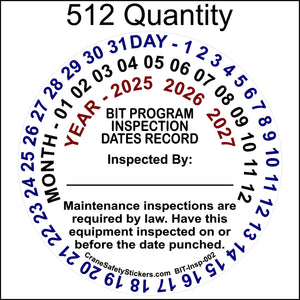
BIT-Insp-002-16qty
BIT PROGRAM INSPECTION DATES RECORD
Inspected By: _______________________
Maintenance inspections are required by law. Have this equipment inspected on or before the date punched.
Each Bit Inspection sticker is printed with all 12 months, 31` days, and 3 consecutive years. This allows the inspector to use a hole punch to select the date for the next bit inspection.
This BIT inspection sticker is 2 1/2 inches in diameter.
Hole Punch For Marking This Inspection Sticker
Follow the link below if you need annual vehicle inspection forms and reports to go with the BIT inspection stickers.
CLICK HERE FOR ANNUAL VEHICLE INSPECTION REPORTS.
The California BIT program requires motor carriers to undergo routine inspections of their terminals and vehicles every two years (biennially). The goal of the program is to ensure that commercial vehicles are maintained in safe working condition, reducing the likelihood of accidents on the road.
Key Components of a California BIT Inspection:
Vehicle Maintenance Records:
Safety Inspection:
Driver Records and Compliance:
Terminal Inspection:
CHP Scoring and Compliance:
Who Must Comply?
Penalties for Non-Compliance: Failure to comply with California's BIT program can result in significant penalties, including fines, impounding of vehicles, and potential suspension of the motor carrier's operating authority.
Why BIT Inspections Matter:
Regular BIT inspections in California are essential for maintaining a safe and compliant fleet, protecting both the carrier and the public. This information can serve as a useful resource for California-based businesses and carriers operating under these regulations.
In todays online deceptive marketplace it is a pleasure to work with a company that sticks to old school principles. This company makes a fantastic product and backs it up with impeccable service. Not only do they deliver a quality product they honor their word, not something you find in most businesses today.
The stickers purchased for the crane direction identification was a great addition for the operators to use the cranes safely. Inspectors I deal with like everything labeled for ease of operation and the safety aspect it offers for the person controlling the cranes and the co-workers that may be around during the operation.
I can't say enough!!! Order was accurate, great quality and service was second to none. Definitely Use for ALL FUTURE ORDERS!!!!!
Great customer service from design to receiving. Thanks
Wow, received great service. Designed the sticker and received in days. Thanks to all your staff.
First off I would like to point out that the customer service is amazing. Secondly, the stickers are the perfect size to not take too much room on a hard hat or a type 2 helmet. We recently made the move to type 2 helmets and my foreman and superintendents were not to ecstatic about it but when they knew they would get new stickers they were happy and specifically asked for some that said they were trained in this. Bought some others from another store but those were round and took up way too much room! Found these and knew that they would be the perfect size. They look great and everyone is happy with them.
These stickers are made out of the great durable material. These fit our type two helmet that the company just moved over to. A lot of our foreman and Superintendent were not happy with the move to the helmets and when we did, they asked specifically for a first aid CPR sticker. I ordered some from another website and those were just too big. They took up too much room, but these were perfect. when I handed them out my guys were ecstatic and happy that these were just the right size for the hardhats that they are utilizing now in the field. The customer service was also a great help in finding these hardhat stickers.
These are great decals. Exactly what I was looking for. High quality and look good too.
Perfect for company cars !!
There are many safety sticker companies today on line, but how many will provide excellent customer service like Crane Safety Stickers? My order had a problem on arrival and after contacting Dave at CSS he promptly responded with an email and immediately packed and shipped a new product the next day. I paid nothing. No charge for a brand new product and no charge for shipping. Hard to beat! I highly recommend Crane Safety Stickers.
These stickers are exactly what we were looking for. The big letters make them easy to read for our energy control program and they don't feel thin and weak. Definitely will be ordering more.
Good product. Good quality. Will buy again.
We've found all of the stickers we need as we update the markings on our electrical boxes. These laminated stickers wipe clean for easy reading in our dirtier locations.
